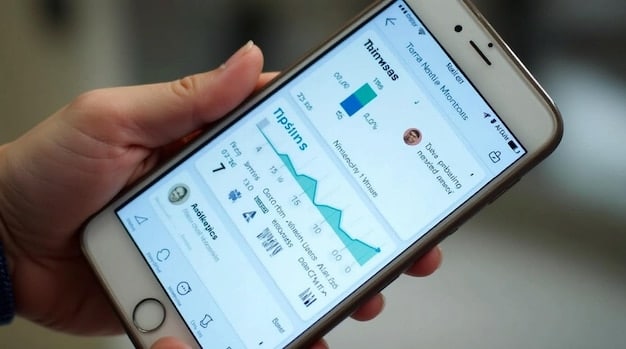Social Media ROI in 2025: 3 Key Metrics for US Campaigns

Social Media ROI for US campaigns in 2025 hinges on tracking three key metrics: engagement rate, conversion rate, and customer lifetime value. These metrics offer actionable insights for optimizing strategies and maximizing marketing outcomes.
In the ever-evolving landscape of social media marketing, measuring the return on investment (ROI) is crucial for success. As we approach 2025, focusing on the right metrics becomes even more critical, especially for US campaigns. This article dives into the three key metrics you should track to maximize your social media ROI and ensure your strategies are hitting the mark.
Understanding Social Media ROI for US Campaigns in 2025
Social media is no longer just about likes and shares; it’s a powerful tool for driving business results. However, to truly understand its effectiveness, you need to measure your ROI. Understanding social media ROI means evaluating the revenue generated from your social media efforts versus the investment made.
Why ROI Matters
Measuring ROI provides invaluable insights into what’s working and what’s not. It helps you justify your social media spend, optimize your campaigns, and ultimately, drive better business outcomes for your US-based campaigns.
Key Performance Indicators (KPIs) vs. ROI
While KPIs are important for tracking progress, ROI goes a step further by quantifying the financial impact of your social media activities. Understanding the difference will allow you to make more informed decisions for your social media strategy.
- KPIs measure performance; ROI measures profitability.
- KPIs focus on specific actions like clicks; ROI looks at overall financial gain.
- Using both ensures you’re tracking progress and justifying investment.
In essence, understanding social media ROI is about making informed decisions based on data. It ensures your efforts translate into tangible business benefits.
Metric 1: Engagement Rate
Engagement rate reflects how actively your audience is interacting with your content. A high engagement rate indicates that your content resonates well with your audience, which is a crucial factor driving revenue.

What Constitutes Engagement?
Engagement encompasses various interactions, including likes, comments, shares, and click-throughs. Each type of interaction contributes to the overall engagement rate.
Tracking these interactions provides a comprehensive view of audience interest and involvement with your Social media ROI.
Calculating Engagement Rate
The formula for calculating engagement rate is: (Total Engagements / Total Reach) x 100. This gives you a percentage that represents the level of interaction your content receives.
Strategies to Improve Engagement Rate
To boost your engagement rate, focus on creating high-quality, relevant content. Here are a few strategies:
- Post visually appealing content that grabs attention.
- Ask questions to encourage comments and discussions.
- Run contests and giveaways to incentivize interaction.
Improving your engagement rate is an ongoing process that requires continuous testing and optimization. Keep refining content and posting strategies to enhance audience interaction.
Metric 2: Conversion Rate
Conversion rate measures the percentage of users who take a desired action after interacting with your social media content. This metric is a direct indicator of how effectively your social media efforts are driving business outcomes.
Defining Conversion
A conversion can be anything from signing up for a newsletter to making a purchase. The key is to align your conversion goals with your overall business objectives.
Tracking conversions helps quantify the financial impact of social media campaigns.
Tracking Conversions
Utilize tools like Google Analytics and social media platform analytics to track conversions. Set up specific goals and events to monitor user behavior.
This data will provide insights into which social media activities lead to the most profitable conversions.
Optimizing for Conversions
To optimize for conversions, make it easy for users to take the desired action. Here are some tips:
- Use clear and compelling call-to-actions (CTAs).
- Create landing pages that are optimized for conversions.
- Test different ad formats and targeting options.
- Ensure the user experience on your landing page is intuitive and seamless to improve Social media ROI.
By focusing on conversion optimization, you can turn social media interactions into valuable business outcomes.
Metric 3: Customer Lifetime Value (CLTV)
Customer Lifetime Value (CLTV) estimates the total revenue a customer will generate throughout their relationship with your company. This metric provides a long-term perspective on the value of acquiring and retaining customers through social media.

Understanding CLTV
CLTV considers factors like average purchase value, purchase frequency, and customer retention rate. It provides a holistic view of customer profitability.
Knowing your CLTV helps justify investments in customer acquisition and engagement strategies.
Calculating CLTV
While there are several formulas for calculating CLTV, a simple one is: (Average Purchase Value x Purchase Frequency) x Customer Lifespan. This calculation provides a ballpark figure for the potential revenue from each customer.
By implementing effective CLTV-centered strategies, you enhance your overall Social media ROI.
Leveraging Social Media to Increase CLTV
Social media is a powerful tool for increasing CLTV through:
- Providing excellent customer service and support.
- Building brand loyalty through consistent engagement.
- Offering exclusive deals and promotions to loyal customers.
By nurturing customer relationships and enhancing their overall experience, you can significantly increase their lifetime value.
Tools and Technologies for Tracking ROI
Effectively tracking social media ROI requires the use of specialized tools and technologies. These platforms provide the data and analytics needed to measure performance and optimize campaigns.
Implementing the right tracking tools will improve your overall Social media ROI.
Google Analytics
Google Analytics is a powerful tool for tracking website traffic and conversions. It can be integrated with your social media campaigns to measure the impact of social media on website performance.
Use Google Analytics to set up goals, track events, and analyze user behavior.
Social Media Platform Analytics
Platforms like Facebook, Instagram, and Twitter offer built-in analytics tools that provide insights into engagement, reach, and demographics. Use these tools to monitor the performance of your social media content.
Understand your audience, track popular posts, and identify trends.
Third-Party Social Media Analytics Tools
Consider using third-party tools like Hootsuite, Buffer, and Sprout Social to manage and analyze your social media efforts. These tools offer advanced analytics features and reporting capabilities.
- Automated Reporting
- Competitive Analysis
- Customizable Dashboards
These tools offer streamlined solutions for monitoring and optimizing your social media campaigns.
Best Practices for Maximizing Social Media ROI
To maximize your social media ROI in 2025, it’s essential to follow best practices and adapt your strategies to the evolving landscape. Staying proactive and informed will allow you to achieve optimal performance and drive tangible business outcomes.
Set Clear Goals and Objectives
Define specific, measurable, achievable, relevant, and time-bound (SMART) goals for your social media campaigns. Align these goals with your overall business objectives.
Having clear objectives will help you measure success and optimize your strategies.
Know Your Audience
Understand your target audience, including their demographics, interests, and online behavior. Use this information to create content that resonates with them.
Tailor your content and targeting to enhance engagement and relevance, maximizing your Social media ROI.
Continuously Test and Optimize
Social media marketing is an ever-evolving field, so continuous experimentation is key. Test different content formats, posting times, and ad creatives to identify what works best for your audience.
Regularly analyze your results and make data-driven adjustments to improve performance.
| Key Metric | Brief Description |
|---|---|
| 👍 Engagement Rate | Measures audience interaction with your content. |
| 💰 Conversion Rate | Tracks the percentage of users taking desired actions. |
| 💎 Customer Lifetime Value | Estimates the total revenue a customer will generate. |
Frequently Asked Questions
▼
Social media ROI measures the profitability of your social media efforts. It compares the revenue generated from social media activities against the cost of those activities, indicating the effectiveness of your social media strategies to drive financial returns.
▼
Engagement rate is important because it reflects how actively your audience is interacting with your content. A high engagement rate signals that your content is resonating with your audience, leading to increased brand awareness, loyalty, and ultimately, conversions.
▼
To track social media conversions, use tools like Google Analytics, social media platform analytics, and third-party analytics tools. Set up specific goals and events to monitor user behavior after they click on your social media content, tracking desired actions such as sign-ups or purchases.
▼
Customer Lifetime Value (CLTV) estimates the total revenue a customer will generate throughout their entire relationship with your company. It considers factors like average purchase value, purchase frequency, and customer lifespan, providing a long-term perspective on the value of acquiring and retaining customers.
▼
To improve Social Media ROI, define clear, measurable objectives, understand your audience, and consistently test different content strategies. Provide excellent customer service, build brand loyalty, and optimize your conversion funnels to maximize long-term customer value.
Conclusion
In conclusion, tracking engagement rate, conversion rate, and customer lifetime value is paramount for optimizing your social media ROI in 2025. By focusing on these three key metrics and implementing effective strategies, you can drive better business outcomes and maximize the value of your social media investments.





